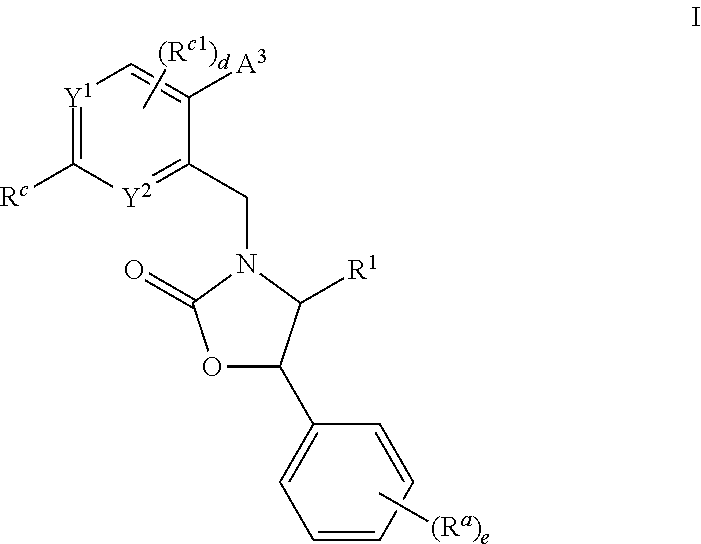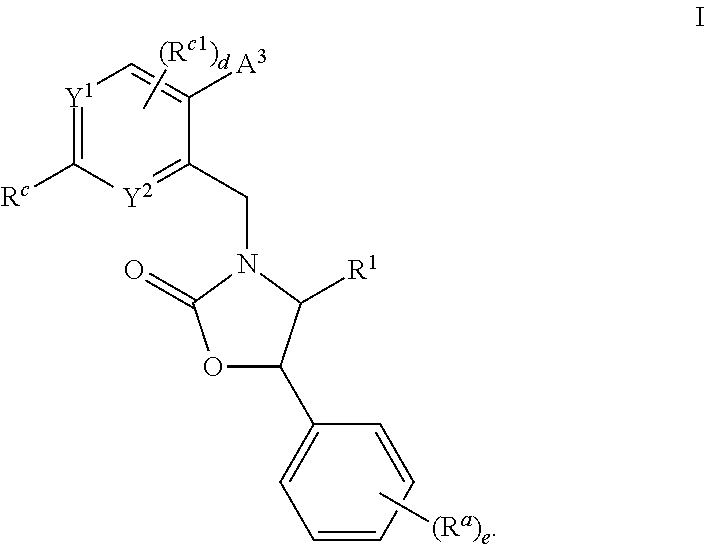Cyclic amine substituted heterocyclic CETP inhibitors
a heterocyclic cetp inhibitor and cyclic amine technology, applied in the field of chemical compounds, can solve the problems of statins only achieving a risk reduction of approximately one-third, and the burden on the health care system is truly enormous
- Summary
- Abstract
- Description
- Claims
- Application Information
AI Technical Summary
Benefits of technology
Problems solved by technology
Method used
Image
Examples
example 1
[0281]
(4S,5R)-5-[3,5-Bis(trifluoromethyl)phenyl]-3-{[5-(5-chloro-2-methoxypyridin-3-yl)-2-(3-fluoroazetidin-1-yl)pyrimidin-4-yl]methyl}-4-methyl-1,3-oxazolidin-2-one
[0282](4S,5R)-5-[3,5-Bis(trifluoromethyl)phenyl]-3-{[5-bromo-2-(3-fluoroazetidin-1-yl)pyrimidin-4-yl]methyl}-4-methyl-1,3-oxazolidin-2-one (INTERMEDIATE 14, 425 mg, 0.763 mmol), 5-chloro-2-methoxypyridin-3-ylboronic acid (214 mg, 1.144 mmol), 1,1′-bis(di-tert-butylphosphino)ferrocene palladium dichloride (49.7 mg, 0.076 mmol) and K2CO3 (316 mg, 2.288 mmol) were added to a reaction vial that was evacuated and charged with nitrogen three times. The solid reactants were then mixed with THF (4 mL) and water (400 μl), degassed and refilled with nitrogen, capped and heated for 30 minutes at 125° C. in a BIOTAGE microwave reactor, after which LCMS showed complete conversion to product. The reaction was diluted with 5 mL acetonitrile and filtered through a 1 g RP C18 silica cartridge, eluting with 15 mL acetonitrile until filtra...
example 2
[0283]
(4S,5R)-5-[3,5-Bis(trifluoromethyl)phenyl]-3-{[2-(3-fluoroazetidin-1-yl)-5-(5-isopropyl-2-methoxypyridin-3-yl)pyrimidin-4-yl]methyl}-4-methyl-1,3-oxazolidin-2-one
[0284](4S,5R)-5-[3,5-Bis(trifluoromethyl)phenyl]-3-{[5-bromo-2-(3-fluoroazetidin-1-yl)pyrimidin-4-yl]methyl}-4-methyl-1,3-oxazolidin-2-one (INTERMEDIATE 14, 1.2 g, 2.153 mmol), 5-isopropyl-2-methoxypyridin-3-ylboronic acid (0.716 g, 2.58 mmol), 1,1′-Bis(di-tert-butylphosphino)ferrocene palladium dichloride (211 mg, 0.323 mmol) and K2CO3 (893 mg, 6.46 mmol) were added to a reaction vial that was evacuated and charged with nitrogen three times. The solid reactants were then mixed with THF (15 mL) and water (3 mL), degassed and refilled with nitrogen, capped and heated for 1 hour at 50° C. in a BIOTAGE microwave reactor, after which LCMS showed complete conversion to product. The reaction was diluted with 50 mL ethyl acetate and poured into 100 mL sat′d NH4Cl soln. The ethyl acetate layer was washed with brine (100 mL) f...
example 3
[0285]
(4S,5R)-5-[3,5-Bis(trifluoromethyl)phenyl]-3-({5-[5-(2,4-dimethyl-1,3-thiazol-5-yl)-2-methoxypyridin-3-yl]-2-(3-fluoroazetidin-1-yl)pyrimidin-4-yl}methyl)-4-methyl-1,3-oxazolidin-2-one
[0286](4S,5R)-5-[3,5-Bis(trifluoromethyl)phenyl]-3-{[5-(5-chloro-2-methoxypyridin-3-yl)-2-(3-fluoroazetidin-1-yl)pyrimidin-4-yl]methyl}-4-methyl-1,3-oxazolidin-2-one (EXAMPLE 1, 100 mg, 0.161 mmol), 2,4-dimethyl-5-(4,4,5,5-tetramethyl-1,3,2-dioxaborolan-2-yl)-1,3-thiazole (38.6 mg, 0.161 mmol) and K2CO3 (66.9 mg, 0.484 mmol) were mixed with 1.5 mL of 4 / 1 dioxane / water. The mixture was evacuated and charged with nitrogen three times, then {2-[2-(amino-κN)ethyl]phenyl-κC1}(chloro)[di-tert-butyl(2′,4′,6′-triisopropylbiphenyl-2-yl)phosphine]palladium (tert-Butyl X-Phos Precatalyst) (8.3 mg, 0.016 mmol) was added. The reaction was sealed and then heated for 25 minutes at 130° C. in a microwave reactor. The reaction was diluted with 5 mL acetonitrile and filtered through a 1 g RP C18 silica cartridge, ...
PUM
| Property | Measurement | Unit |
|---|---|---|
| concentration | aaaaa | aaaaa |
| concentration | aaaaa | aaaaa |
| density | aaaaa | aaaaa |
Abstract
Description
Claims
Application Information
 Login to View More
Login to View More - R&D
- Intellectual Property
- Life Sciences
- Materials
- Tech Scout
- Unparalleled Data Quality
- Higher Quality Content
- 60% Fewer Hallucinations
Browse by: Latest US Patents, China's latest patents, Technical Efficacy Thesaurus, Application Domain, Technology Topic, Popular Technical Reports.
© 2025 PatSnap. All rights reserved.Legal|Privacy policy|Modern Slavery Act Transparency Statement|Sitemap|About US| Contact US: help@patsnap.com



